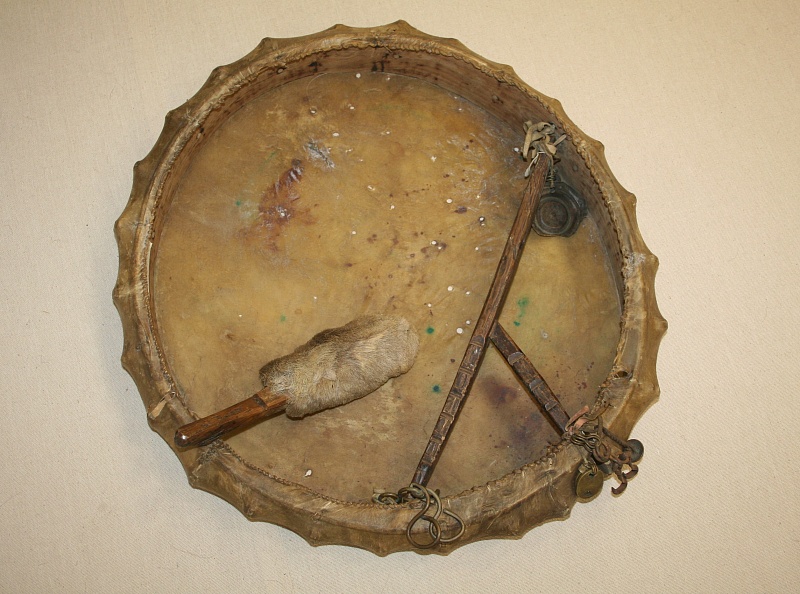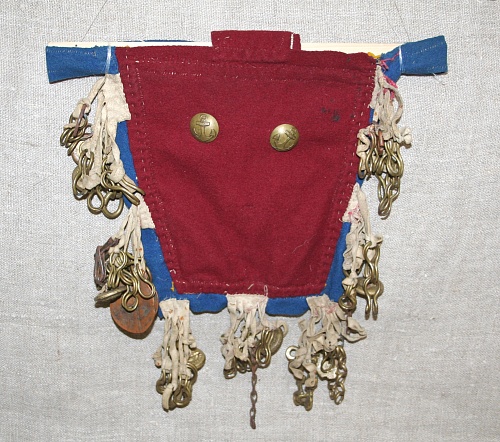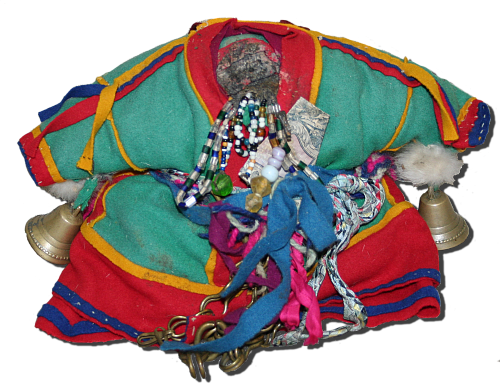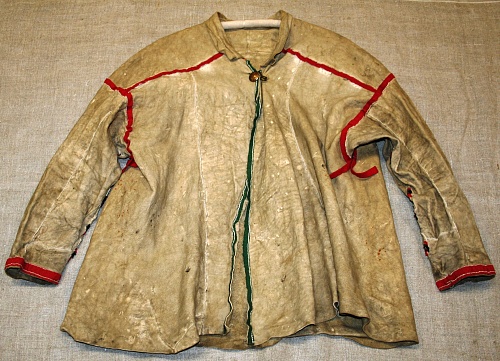Бубен (пензер) и колотушка (пенгабць)
Прослушать информацию
Этикетаж
НКМ КП ОФ-2449
№ ГК 16541953
Бубен шамана Ардеева Ивана Васильевича (Пурпэю)
Место создания: остров Колгуев
Дата создания: конец XIX в.
Материал: кожа оленя, дерево, металл, жилы оленя
Техника: ручная работа, резьба, штамповка
Размеры: 7,0х57,0x57,0 см
НКМ КП ОФ-3838
№ ГК 16443674
Колотушка (пенгабць) от шаманского бубна
Место создания: Канинская тундра
Дата создания: конец XIX-начало XX вв.
Материал: мех, дерево
Техника: ручная работа
Размеры: 26,0x7,0x4,0 см
№ ГК 16541953
Бубен шамана Ардеева Ивана Васильевича (Пурпэю)
Место создания: остров Колгуев
Дата создания: конец XIX в.
Материал: кожа оленя, дерево, металл, жилы оленя
Техника: ручная работа, резьба, штамповка
Размеры: 7,0х57,0x57,0 см
НКМ КП ОФ-3838
№ ГК 16443674
Колотушка (пенгабць) от шаманского бубна
Место создания: Канинская тундра
Дата создания: конец XIX-начало XX вв.
Материал: мех, дерево
Техника: ручная работа
Размеры: 26,0x7,0x4,0 см
Labeling
NKM KP OF-2449
GK No. 16541953
The tambourine of the shaman Ardeev Ivan Vasilievich (Purpeyu)
Place: Kolguev Island
Date: late 19th century
Material: reindeer skin, wood, metal, deer tendons
Technique: handmade, carving, stamping
Dimensions: 7.0x57.0x57.0 cm
NKM KP OF-3838
GK No. 16443674
The drumstick (pengabts’) of the shaman tambourine
Place: the Kaninskaya tundra
Date: late 19th-early 20th centuries
Material: fur, wood
Technics: handmade
Dimensions: 26.0 x 7.0 x 4.0 cm
GK No. 16541953
The tambourine of the shaman Ardeev Ivan Vasilievich (Purpeyu)
Place: Kolguev Island
Date: late 19th century
Material: reindeer skin, wood, metal, deer tendons
Technique: handmade, carving, stamping
Dimensions: 7.0x57.0x57.0 cm
NKM KP OF-3838
GK No. 16443674
The drumstick (pengabts’) of the shaman tambourine
Place: the Kaninskaya tundra
Date: late 19th-early 20th centuries
Material: fur, wood
Technics: handmade
Dimensions: 26.0 x 7.0 x 4.0 cm
Важнейшим атрибутом шамана являлся его бубен и колотушка.
Бубен – принадлежность только посвящённых шаманов. С помощью его звуков шаман вызывал духов. Бубен в культуре ненцев символизировал оленя, на котором шаман путешествовал по Верхнему, Среднему и Нижнему мирам.
Ненецкий бубен изготавливали из дерева и кожи оленя. Обечайку делали из срубленного хвойного дерева (лиственницы, сосны сибирской). На неё натягивали кожу самца дикого или домашнего оленя. Бубен "оживляли" дымом. Камлать (священнодействовать) можно было через двое - четверо суток. Никто, кроме хозяина, не имел права его трогать. Ненцы верили, что духи подвергали человека строгому наказанию за нарушение правил обращения с ритуальными атрибутами. После смерти шамана, если у него не было наследников-преемников, пензер повреждали и вешали на могилу тадебя-владельца.
Колотушка для ненецкого бубна изготовлялась из дерева или из кости и имела обычно форму лопатки с рукоятью. У шаманов европейских тундр колотушкой к бубнам часто служила заячья, собачья, оленья лапка или просто палка, обшитая кожей росомахи.
К помощи шамана прибегали почти во всех важных для ненцев случаях жизни. Это могла быть пропажа оленей, болезнь, отправка на промысел. Шаман совершал камлание – способ общения шаманов с духами. С помощью звуков бубна шаман вызывал духов.
Во второй половине XX столетия бубен (пензер) потерял своё сакральное значение и стал использоваться в качестве музыкального инструмента для выступлений национальных ансамблей народов Севера.
Бубен – принадлежность только посвящённых шаманов. С помощью его звуков шаман вызывал духов. Бубен в культуре ненцев символизировал оленя, на котором шаман путешествовал по Верхнему, Среднему и Нижнему мирам.
Ненецкий бубен изготавливали из дерева и кожи оленя. Обечайку делали из срубленного хвойного дерева (лиственницы, сосны сибирской). На неё натягивали кожу самца дикого или домашнего оленя. Бубен "оживляли" дымом. Камлать (священнодействовать) можно было через двое - четверо суток. Никто, кроме хозяина, не имел права его трогать. Ненцы верили, что духи подвергали человека строгому наказанию за нарушение правил обращения с ритуальными атрибутами. После смерти шамана, если у него не было наследников-преемников, пензер повреждали и вешали на могилу тадебя-владельца.
Колотушка для ненецкого бубна изготовлялась из дерева или из кости и имела обычно форму лопатки с рукоятью. У шаманов европейских тундр колотушкой к бубнам часто служила заячья, собачья, оленья лапка или просто палка, обшитая кожей росомахи.
К помощи шамана прибегали почти во всех важных для ненцев случаях жизни. Это могла быть пропажа оленей, болезнь, отправка на промысел. Шаман совершал камлание – способ общения шаманов с духами. С помощью звуков бубна шаман вызывал духов.
Во второй половине XX столетия бубен (пензер) потерял своё сакральное значение и стал использоваться в качестве музыкального инструмента для выступлений национальных ансамблей народов Севера.
A tambourine (penzer) and a drumstick (pengabts')
The most important attribute of a shaman was his tambourine and drumstick. With the help of tambourine sounds, a shaman summoned spirits. In the Nenets’ culture, a tambourine symbolized a reindeer, on which a shaman travelled across the Upper, Middle and Lower worlds. A tambourine can be owned only by consecrated shamans.
The Nenets tambourine was made of wood and reindeer skin. The drum shell was made of coniferous wood (larch, Siberian pine). The skin of a male wild or domestic reindeer was pulled over it. Then the tambourine was "vivified" with smoke. Kamlats (ritual performances) could be performed in two-four days. No one, except the owner, had the right to touch a tambourine. The Nenets believed that the spirits subjected a person to severe punishment for violating the rules of handling with ritual attributes. After the shaman’s death, if he had no heirs or successors, the penzer was damaged and hung on the owner’s grave.
A drumstick for the Nenets tambourine was made of wood or bone and usually had an oval shape with a handle. A hare, dog, reindeer’s foot or just a stick trimmed with wolverine skin often served as a drumstick among the shamans of the European tundra.
The Nenets asked for the help of a shaman in almost all life important cases: loss of reindeer, an illness or poor haul of fish. A shaman performed a ritual called “kamlanie” - the special ritual activities of a shaman during which he appears to communicate with the spirits. With the help of tambourine sounds, a shaman summoned the spirits.
In the second half of the 20th century, the tambourine (penzer) lost its sacred significance and became a musical instrument for the national ensembles’ performances of the peoples of the North.
The Nenets tambourine was made of wood and reindeer skin. The drum shell was made of coniferous wood (larch, Siberian pine). The skin of a male wild or domestic reindeer was pulled over it. Then the tambourine was "vivified" with smoke. Kamlats (ritual performances) could be performed in two-four days. No one, except the owner, had the right to touch a tambourine. The Nenets believed that the spirits subjected a person to severe punishment for violating the rules of handling with ritual attributes. After the shaman’s death, if he had no heirs or successors, the penzer was damaged and hung on the owner’s grave.
A drumstick for the Nenets tambourine was made of wood or bone and usually had an oval shape with a handle. A hare, dog, reindeer’s foot or just a stick trimmed with wolverine skin often served as a drumstick among the shamans of the European tundra.
The Nenets asked for the help of a shaman in almost all life important cases: loss of reindeer, an illness or poor haul of fish. A shaman performed a ritual called “kamlanie” - the special ritual activities of a shaman during which he appears to communicate with the spirits. With the help of tambourine sounds, a shaman summoned the spirits.
In the second half of the 20th century, the tambourine (penzer) lost its sacred significance and became a musical instrument for the national ensembles’ performances of the peoples of the North.
Посмотреть расположение

 Выберите язык
Выберите язык







